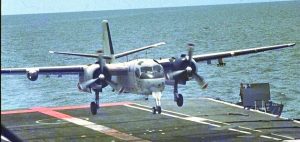
Two engine Carrier-based anti-submarine search and attack aircraft
History of Type
The Tracker is an aircraft carrier based Anti Submarine Warfare (ASW) aircraft designed for the US Navy by the Grumman Aircraft Co in 1950 with the first flight in December 1952.
The aircraft was designed to take–off and land on aircraft carriers with its main role being to protect the aircraft carriers by detecting and hunting enemy submarines. It did this with its retractable Magnetic Anomaly Detector (MAD) boom – an airborne metal detector and sonobuoys (water proof floating microphones) that could hear the submarine underwater.
On detecting a submarine it would attack it with homing torpedos, and depth charges from its bomb bay. Being based on an aircraft carrier, space is at a premium, so the aircraft is physically not big. Its ~6 m long MAD boom was retractable back into the fuselage and its wings were foldable. It has a large strong hook at the rear to catch the landing wires on the aircraft carrier deck.
~32 Trackers used by the RAN from ~1966 to retirement in ~1984.
History of N12-152812
The HARS Tracker is built in 1966 for the US Navy and served firstly on board the aircraft carrier USS Hornet during the Vietnam War, followed by the USS Ticonderoga and lastly the USS Kittyhawk. She was retired in 1976 and put into storage at Davis Montham (The Famous Boneyard) at Tucson.
She came to Australia in 1977 as one of a number of replacement Trackers to replace 9 Trackers that were destroyed in a hangar fire at HMAS Albatross (Nowra) in December 1976. She was used aboard the aircraft carrier HMAS Melbourne, the Naval Air Station HMAS Albatross at Nowra and lastly for coastal surveillance of the NW Shelf of WA.
In 1990 our Tracker #851 was sold to QANTAS as an apprentice training aid, and in 2006 HARS acquired it. It is being rebuilt to running and taxiing condition.
Technical Specifications
Engines: 2 x Wright R1820-82WA 9 cylinder supercharged air-cooled radials (~30 L), 1,500 bhp each
Maximum takeoff weight: 11,860 kg (2,200 kg payload)
Length: 13.26 m
Wing span: 22.13 m (8.33 m folded)
Height: 5.33 m
Patrol speed: ~240 km/h (max ~450 km/h)
Ceiling: 22,000 ft
Range: ~2,200 km (~9 hours)
Crew: 2 x pilots, 2 x Weapons Systems Operators
